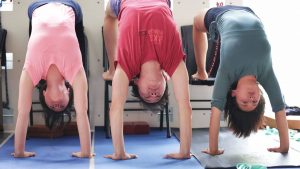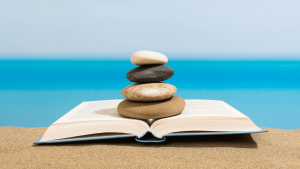“We are missing the gold if we do asanas as a physical practice only.”
(Geeta Iyengar)
In my March blog post, I was highlighting the many health and wellness benefits that come with yoga practice, and in particular, with Iyengar Yoga.
But yoga is, of course, so much more than physical exercises and postures on a mat. The word itself – yoga – means to unite, to connect, but also to disentangle. What we are trying to connect to is our soul, our true or ultimate self. What we are aiming to separate ourselves from in yoga is what stops us from feeling free.
So today, I’d like to build on my last blog and examine living yoga, how to integrate the principles of yoga into thoughts, words and actions and attain freedom.

Patanjali’s Yoga Sutras describe an eight-fold path leading to freedom. Known as the 8 limbs of yoga, this path seeks to provide guidance on how to live purposefully and meaningfully.
The Iyengar Yoga system bears many similarities to the Yoga Sutras. Iyengar Yoga Asanas are designed to build upon each other. Sequencing and timing create evolution and allow to elevate the structure of the serene mind and enter a yogic state. Ultimately, it is a practice to transform and benefit every aspect of life.
What are the eight limbs of Yoga?
Throughout life, we pick up habits. These habits may or may not serve us.
The idea of life yoga, of our practice, is to understand what helps us and what doesn’t and strive to achieve a state in which all our thoughts, words and actions aid us towards being happier, healthier and more aware in life.
According to Patanjali’s Yoga Sutras, the path to freedom consists of
- Yama – (Self)-Restraint, Moral Discipline or Moral Vows
- Niyama – Positive Duties, Observance
- Asana – Movement and Posture
- Pranayama – Breath, Breathing Techniques
- Pratyahara – Sense Withdrawal
- Dharana – Concentration
- Dhyana – Meditation
- Samadhi – Union, Bliss or Enlightenment
- Yama
This first limb is concerned with the world around us, how we interact with it and conduct ourselves. It relates to our ethical standards and our sense of integrity. It aims to teach us to be truthful and kind and use our energy to benefit ourselves and others.
- Niyama
Niyama, the second limb, is typically concerned with duties towards ourselves but also actions towards others. The five Niyamas are cleanliness, contentment, discipline and desire, self-reflection and the study of spiritual texts, and a surrender to a higher power. Niyamas are intended to be character building. Developing your personal meditation practices, making a habit of taking walks to reflect and contemplate, or having a clean place to practice are all examples of Niyamas in practice.
- Asanas
The third limb on the path to freedom relates to the physical aspect of yoga. It supports the view that our body is a spirit temple, and taking care of it is an important stage of our spiritual growth. In this context, Asanas relate to the idea of sitting in comfort, without aches and pains or restlessness. It lets us know that the most essential posture is the one the yoga practitioner can hold motionless and comfortably. The practice of Asanas allows us to develop discipline and an ability to concentrate and ultimately support meditation.
- Pranayama
Breath is the very essence that keeps us and the universe around us alive. This fourth stage involves breathing techniques designed to achieve mastery of breathing while recognising the connection between breath, mind and emotions. Understanding and practising different breathing techniques allow us to change our state of being. For example, we can choose stimulating or calming practices, and we can see this as either freeing ourselves from habits or controlling the way we feel.
- Pratyahara
The word pratya refers to ‘withdraw’, ‘draw in’ or ‘draw back’, and ahara to anything we ‘take in’ through our senses, such as smells, sights and sounds. For example, focusing on ‘drawing in’ is very likely the first thing we do when practising meditation. We are focusing on breathing, thus practising the fourth limb, pranayama, as well. Pratyahara allows us to focus so that sounds, sights and smells no longer bother us, and we can be present in the moment, and meditate without distraction. It allows us to step back and objectively observe ourselves, our habits, cravings, anything that may interfere with our inner growth.
- Dharana
Each stage builds on and prepares us for the next. In the previous three stages of posture, breath control and withdrawal of the senses, we’ve already started to develop focused concentration, the 6th limb of yoga. In Asana and Pranayama, our attention focus shifts as we fine-tune a breathing technique or a specific posture. In the 5th limb, Pratyahara, we step back and take a look at ourselves. In Dharana, we build on this, and our concentration focuses on a single point.
- Dhyana
The seventh limb on the path to liberation is meditation or contemplation, the uninterrupted flow of concentration. It differs from Dharana in that it moves away from one point of concentration to a state of being keenly aware without focus. At this stage, the mind is still and produces few or no thoughts. This may seem an impossible task. It requires strength to achieve this stillness. Remember it is a process, be patient with yourself and know that the journey is already of immense benefit to your wellbeing.
- Samadhi
In this 8th and final stage of Patanjali’s Yoga Sutras, we’ve rearranged our relationships with our inner world and the outside world and transcended the self altogether. We’ve come to understand the interconnectedness of all living things and have arrived at a state of peace and bliss.

Iyengar Yoga and Patanjali’s Yoga Sutras
“Yoga, an ancient but perfect science, deals with the evolution of humanity. This evolution includes all aspects of one’s being, from bodily health to self-realisation.”
(B.K.S Iyengar)
It’s B.K.S Iyengar who outlined his view on the eight limbs of yoga best in a speech given in London in 1997. Iyengar Yoga and Patanjali’s eight limbs of yoga are intrinsically intertwined and built on the same foundation.
Both share a holistic approach and take great care to build upon and extend the practice of yoga, connecting body, mind and soul with care and focus.
In Iyengar Yoga, three important aspects support this development: technical intricacies, sequencing and timing.
Like the Yoga Sutra’s build on each other, so does sequencing. Naturally, if you do just one pose, one asana, it will have a particular effect. But if you stop at one asana, you will deprive yourself of evolution and progress; you will only go so far. However, with the structure of proper sequencing, the effect of the asana can be built up. How you have done a pose, and why will determine how you should do the next one.
The purpose of sequencing is to raise or elevate the structure of the serene mind and enter a yogic state.
So, when you get a peaceful or sublime mind after a good yoga class, it is not because of one asana but because of the correct sequencing of asana. You receive the accumulated benefits and overall augmented effects!
However, you need to blend your sequencing with technical intricacies and proper timing. They will all have to work together in unison; they are equal partners. If, for example, you meticulously observe all technicalities but do not practice your timing, you will not get the intended effect of the sequence.
You might think sequencing is very disciplined. It is not! It really depends on your frame of mind and how and why you have done the previous posture. It’s a subjective science and judgement.
I’d like to note here that it’s important to me that I can support each student individually and develop their practice at a pace that is appropriate and suitable for them. Building up your practice takes time, and it takes commitment. I have been practising yoga for 40 years now and continue to learn and grow!
What do we want out of life?
You might think that especially the final stage of the Yoga Sutras – Samadhi – is a lofty and out-of-reach goal. And on the surface of things, that might seem true. But ultimately, aren’t we all deep down somewhere, wishing for happiness and peace? And that is really what Patanjali’s eight limbs of yoga offer, a yogic pathway to fulfilment and being at one with the universe.
Let me share this wonderful practice with you. It is important to me that I understand and support the individual and thus empower them. If you would like to learn more about the practice of yoga, Iyengar yoga in Melbourne, or the many benefits of this practice, please be in touch.
Namaste
Peter Scott



